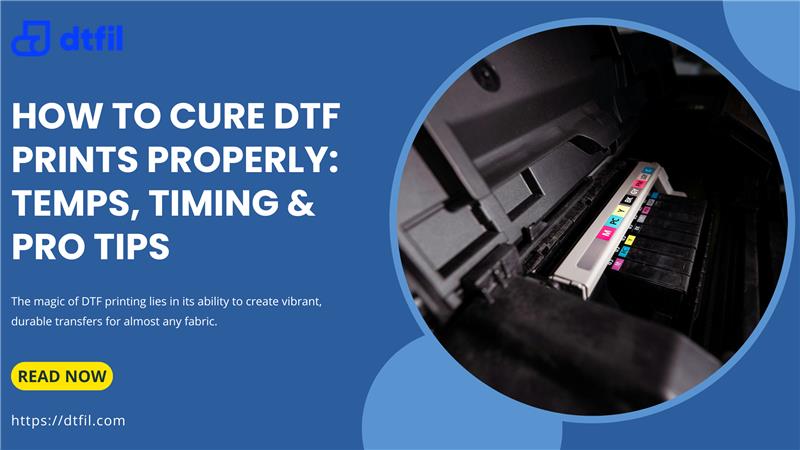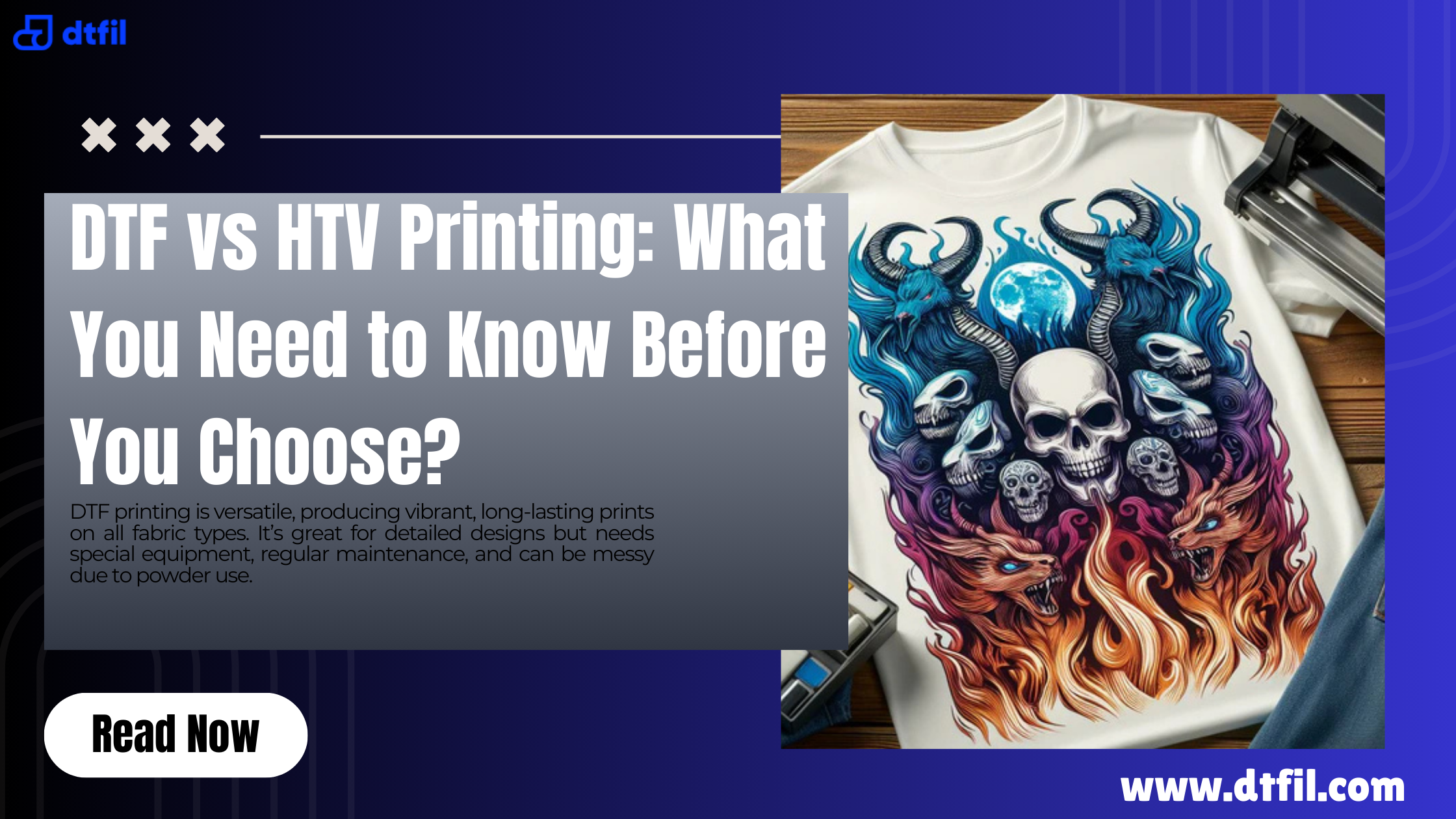DTF (Direct-to-Film) transfer is an innovative form of printing that enables complicated, vivid images to be engraved on a wide variety of fabrics through the use of a film and heat press. Different from other methods, DTF prints on cotton, polyester, and many other kinds of fabric, without involving the pre-treatment process. It also has the flexibility and economical point of view which make custom printing popular. As a result, using DTF, it is possible to achieve long-lasting high-quality prints with increased wear resistance, fade, and peel resistance. The benefits realized are that this technology makes the custom printing business more flexible and efficient.
To assist you in achieving higher-quality prints, we'll be discussing all you need to know about DTF transfers in this blog.
What Does DTF Transfer Mean?
DTF means direct-to-film transfer and it is a new generation of printing techniques in the field of custom printing. DTF transfers are different from normal printing techniques since they enable you to print your designs on a film that can then be transferred to garments via heat. These designs are printed in the reversed form on the film and this can be easily transferred to other fabrics such as cotton, polyester, blends, and even dark ones. It has therefore rendered DTF as one of a kind for custom printing businesses due to these unique characteristics.
The main advantage of DTF transfers is that they offer great print quality and durability of the prints. They also have great flexibility, specify a design of any level of difficulty, a wide range of bright and deep colors, and the possibility of using white ink, which is extremely important when working with dark materials. As more and more people are interested in receiving their custom outfits, what does DTF transfer mean for other forms of custom printing? It implies a shorter time to produce a product, restrictions, and constraints are minimized and creativity is rightly enhanced.
Also Read: What Kind of Printer Do I Need for DTF Transfers? Comparing the Options
What Does DTF Stand for in Printing?
In the world of printing, DTF stands for Direct-to-Film, a process where designs are printed onto a film and then heat-pressed onto the fabric. This method differs significantly from other techniques like Direct-to-Garment (DTG) printing, screen printing, and sublimation. DTF printing allows for high-quality results on a wider range of materials, making it one of the most adaptable printing solutions on the market.
However, what is causing DTF to receive such a positive response? First, if someone asks what does DTF stand for in printing it is not just an abbreviation for a pretty name, but in fact, a new technology that brings benefits in the shape of better productivity, quality, and adaptability. DTF on the other hand doesn’t necessitate the washing, or pre-treatment of garments and offers possibilities that DTG doesn’t have. He pointed out, that the fabric can be as simple as cotton, as synthetic as polyester, or as luxurious as leather, or it could be a combination of any of the aforementioned and more, yet DTF can print on it while maintaining the quality of the print.
What Are the Benefits of DTF Transfers?
The benefits of DTF transfers include but are not limited to the following; This is why DTF transfers are quite popular in the custom printing industry. Let's explore the key advantages:
- Versatility: DTF transfers may apply to a virtually limitless array of fabrics including cotton, polyester, and nylon blends as well as man-made manufactured fabrics. It also guarantees flexibility for the printing service providers in the sense that a specific printer can serve a large clientele without having to adopt a different method of printing for different materials.
- Vibrant Colors: DTF printing is also characterized by rich and rich colors and the ability to print white ink. This makes it ideal to be used on black clothes or designs that require almost popping artwork as their design.
- Durability: It has been noted that prints made from DTF transfers are quite long-lasting and with features such as no fading, peeling, or cracking. This is especially true for bespoke garments especially when one is going to wash them frequently.
- Cost-Effective: Actually, DTF transfers are cheaper than most of the other types of printing methods, especially for short and bulk runs. This saves on the amount of consumables used; garments do not have to be pre-treated as is the case with some standard processes.
- No Limitations on Fabric Color: DTF printing also allows printing on both light and dark materials, a factor that is hard to come across with other forms of printing.
- Eco-Friendly: The inks that are employed in DTF printing are majority water soluble making it a green solution for custom services.
Also Read: How to Remove DTF from a Shirt Without Ruining the Fabric
What Does DTF Mean for Shirts?
Thus, what does DTF mean for shirts, for custom apparel businesses? That is how awesome designs have to be – very crisp and vivid so that they can be seen on both bright and dark T-shirts. Unlike screen printing wherein additional costs are incurred when it comes to the complexities of the design, DTF makes it possible to print complex images without extra charges.
DTF has the following benefits particularly when it comes to the production of custom shirts. First, is the fact that there is no restriction in the design patterns in regards to the type of fabric to be used. In other words, DTF can deliver your customers anything that they may be interested in from cotton, polyester, or blends of the two. Second, DTF transfers carry the capacity to mimic the finer elements in a design and are preferable for logos, artworks, and wordings. Third, due to the durability of DTF prints, customers’ custom shirts will not fade or crack after washing and provide a long-lasting quality for the consumers.
What Are DTF Transfers?
In other words, what are DTF transfers? They are a kind of transfer that refers to the process of printing your design on a particular film with a specific type of ink known as DTF ink which comprises white ink but for the base layer. After the printing process, the adhesive powder is covered on the film then it is heated and dried before it is applied to the fabric through a heat press.
The following is a guide as to the benefits that come with those transfers and the kind of printing that is involved in this process against other forms of transfers and printing. For example, they are not primarily done with polyester-based materials and can be applied to a much greater number of substrates than sublimation. In addition, print quality is better than Heat Transfer Vinyl (HTV), meaning fine details and better color distinction.
DTF transfers are becoming the popular method of reproducing images in custom printing because of the flexibility, bright and clear colors, and durability of prints in addition to being cheaper than many forms of replication.
Pros and Cons of DTF Transfers
Like any printing method, DTF comes with its pros and cons. Here's a balanced view:
Pros:
- Versatile: Works on multiple fabric types and colors.
- High-Quality Prints: Offers vibrant and durable prints.
- Cost-Effective: Ideal for both small and large print runs.
- No Fabric Pretreatment: Unlike DTG, DTF does not require pretreatment of garments.
- Eco-Friendly: Water-based inks are often used, reducing environmental impact.
Cons:
- Adhesive Powder Step: The need to apply adhesive powder can be messy and adds an extra step.
- Special Equipment: While not as costly as DTG, DTF still requires specific printers and heat presses.
- Storage Considerations: DTF transfers require careful storage to prevent degradation.
Also Read: How to Press DTF Transfers Like a Pro: Secrets from the Experts
DTF Transfer Cost
The cost of the transfer in terms of DTF Transfer cost is usually cheaper compared to other printing techniques such as screen printing or DTG. The only costs are the printer, special films, inks, and adhesive powder, but their cost is significantly lower than for other similar solutions that would require more expensive equipment and configuration. Also, since DTF printing does not require pre-treatment of garments, you commence the process cutting on several costs and time drastically making it an economically viable custom printing business model.
For businesses that deal with both small orders as well as large ones, the STL & TL values and the ability to work with various fabrics; DTF has a lower setup cost. Furthermore, holding transfers for later use will bring down the production time thus cutting down costs for future manufacture.
DTF transfers are revolutionizing the custom printing industry by offering an adaptable, high-quality, and cost-effective solution for creating vibrant designs on a wide range of fabrics. Whether you’re a business owner or a custom printing enthusiast, DTF is a versatile and efficient option that provides superior results with fewer limitations. The ability to produce long-lasting, detailed prints makes DTF a smart choice for creating custom apparel.
Ready to explore DTF transfers for your printing needs? Visit DTFIL today and discover how this game-changing technology can transform your custom printing projects.
FAQs on DTF Transfers
How does DTF transfer work?
DTF transfer is based on the principle where DTF inks print the design in reverse onto a special film and the surface you want to adhere the printed design on, is coated with DTF inks which include white ink for the base layer. After printing, the film is covered with the adhesive powder which is then treated and then applying it on the fabric by using a heat press.
Is DTF better than sublimation?
Indeed, DTF can be better than sublimation since DTF can be used on several types of fabrics including cotton, polyester, and blended fabrics while sublimation works well on polyester fabric only.
How long do DTF transfers last?
DTF transfers take a long to wear out and can easily last for several washing cycles without fading, peeling, or cracking making it ideal when it comes to personalized clothing.
Is DTF better than vinyl?
Yes, DTF is said to be worse than vinyl because it enables better complexity of the designs, better color quality, as well as its durability. Vinyl material can fade or even emit a cracking sound after some time especially if it was put on a delicate pattern.
What Does DTF Transfer Mean?
DTF (Direct-to-Film) transfer is a printing method where designs are printed onto a special film and then transferred to fabric using heat and pressure. It works on a variety of fabrics, such as cotton and polyester, without needing pre-treatment, and produces durable, vibrant prints that resist fading and peeling.








